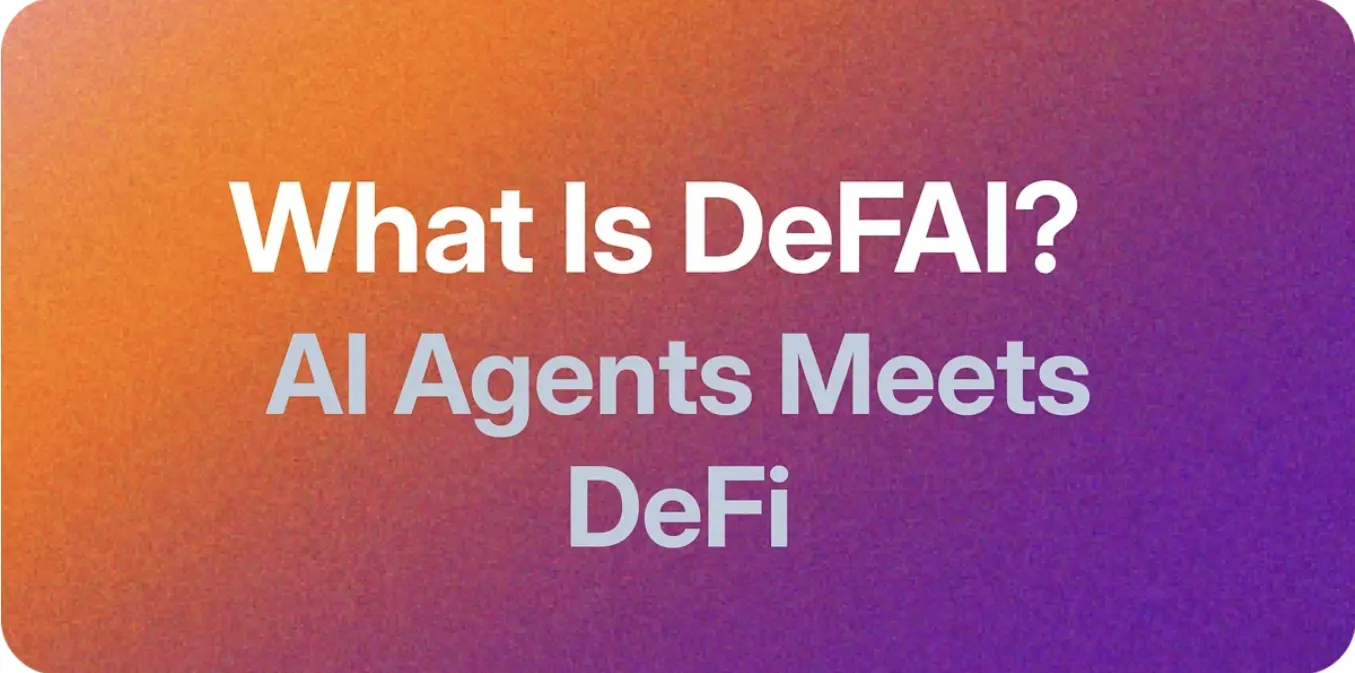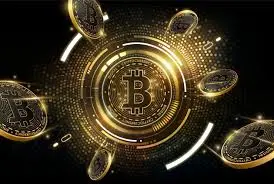Chapter 6: Game
The Game Economy
Games are always built within isolated bubbles controlled by centralized entities. Entities control the rules of the system, and developers or publishers often impose strict conditions on the currency within the game.
Players are usually restricted from selling their in-game items or assets for fiat currency. Often, they have to resort to the illegal use of third-party platforms, relying on insecure peer-to-peer (P2P) transactions. Most importantly, these digital assets are ultimately owned and controlled by the developers.
While most players may be satisfied with the status quo, it is undeniable that restrictions exist. Many players value their virtual property, but if game developers have the right to take those assets away from you, can you truly say you own them? From a technical perspective, games are also limited to virtual interactions, and valuable items are locked within a specific game, perhaps with the exception of large game franchises with powerful development teams (e.g., Pokémon).
Now imagine a digital world where games are interconnected, and players can move avatars, assets, and currencies between each other. If you've seen the movie "Ready Player One" (or even read the book), you might resonate with this idea. In "traditional games," one example we can think of is Pokémon HOME, a mobile application that allows assets to be transferred across different Pokémon series and Nintendo consoles via cloud computing.
However, the issues with Pokémon HOME (and generally all games) are:
1. The interactivity of the game is limited to the Pokémon series and not other games.
2. Creating "hacked Pokémon" is a very common phenomenon.
3. Player autonomy is still restricted by developers.
4. There is no (legal) way to sell game assets or other virtual assets.
Recognizing the limitations of "traditional games," developers are leveraging blockchain technology to create games that give players more freedom and autonomy over in-game items and currencies. A significant part of this process involves creating NFTs and tokens to represent digital assets and in-game currencies. This may seem trivial, but its impact is more significant than you might think.
Once in-game currencies and items are deployed as tokens and NFTs, they become accessible on decentralized exchanges (DEXs) and NFT marketplaces. In other words, players can freely trade and exchange these items for other cryptocurrencies like Dai, USDC, Ethereum, or even other game assets. This results in greater player autonomy, as NFTs provide true ownership and allow players to freely manage these assets.
At the same time, it also limits asset hacking, as the security provided by blockchain means new assets can only be created out of thin air. However, it is important to note that if there are flaws in the smart contracts (e.g., infinite minting) or the game itself (e.g., information hacks, infinite energy generation, etc.), other forms of hacking may still occur.
In this chapter, we will introduce three NFT games and delve into the emerging play-to-earn (P2E) economy.
Axie Infinity

"Axie Infinity" was originally developed by the game studio Sky Mavis in 2018. In "Axie Infinity," Axies (virtual pets) and land (virtual land) are represented as NFTs. These NFTs are primarily traded on Sky Mavis's own Ethereum sidechain, Ronin.
"Axie Infinity" has become very popular in many developing countries due to its play-to-earn (P2E) elements. P2E refers to a gaming concept where players earn in-game currency by completing certain tasks or achievements. These in-game tokens can also be transferred from the game to wallets or exchanges, where they can be exchanged for other currencies used in the real world.
In May 2021, "Axie Infinity" released a mini-documentary about its growing adoption rate in the Philippines. This earning element in "Axie Infinity" provides a supplementary income source for players of all ages, including those affected by the economic impact of the COVID-19 pandemic.
"Axie Infinity" borrows many elements from Pokémon, including skill cards and a breeding system (similar to Pokémon's moves and IV data). The gameplay can be roughly divided into two core functions: player versus environment (PVE) and player versus player (PVP). In PVE, players play against bots, while in PVP, players compete against each other.
Whether in PVP or PVE, players must carry three Axies. Each Axie has four skills represented by randomly drawn cards each round. There are over 100 different skills and 9 different Axies. "Axie Infinity" also has positioning and energy consumption mechanics.
Unlike most blockchain-based games, "Axie Infinity" can run on Android and Apple devices. This is done through their desktop application, all running on the same server. Therefore, users can play the game for free under one account across all devices. Users must have a Ronin wallet to acquire and breed Axies.
"Axie Infinity" has two fungible tokens - AXS and SLP. Breeding an Axie requires both tokens. An Axie can breed a maximum of 7 times. The cost of breeding is 1 AXS + a certain amount of SLP (depending on the number of times each parent has bred). For example, if one parent has bred 0 times and the other has bred 2 times, the total SLP cost will be 2100 SLP.
One thing to note is that Axies cannot breed with their parents or siblings. This breeding system forms the backbone of the Axie economy.
Cometh

In Cometh, players (also known as cosmic miners) control spaceships, which are NFTs released on the Polygon blockchain. They orbit around giant stars in circular paths, with the main goal of mining tokens from smart asteroids.
The initial parameters of a spaceship's orbit are randomly drawn from the block hash that created it. A spaceship can be pulled towards another spaceship in space to get closer to another smart asteroid.
Spaceships can be upgraded with other NFTs, such as better drilling tools, engines, or crew, which can enhance the mining capabilities of the spaceship, allowing you to earn more rewards.
Pulling is the core mechanism of Cometh. Other players can request pulling services from the spaceship and pay the spaceship owner a fee, which the owner can set and change at will. The ultimate goal is to pull your ship close enough to reach the asteroid's trajectory and earn rewards.
Smart asteroids are smart contracts representing asteroids in the game. Similar to Kepler's First Law in the real world, smart asteroids have an elliptical trajectory around their orbiting star. The trajectory parameters of smart asteroids are randomly drawn from the block hash when the asteroid appears.
The creation of new smart asteroids is a process left to the Cometh generator. It is a smart contract that accumulates yield in the form of Ethereum-based assets (like liquidity pool tokens). Miners can mine asteroids and receive "stored yield" as a reward.
In Cometh V1, these assets are part of the ComethSwap yield fees, which is its own DEX. However, with Cometh V2 (Cometh: Beyond), the developers plan to introduce a new fee system that will only be disclosed in their upcoming white paper V2.
Gods Unchained
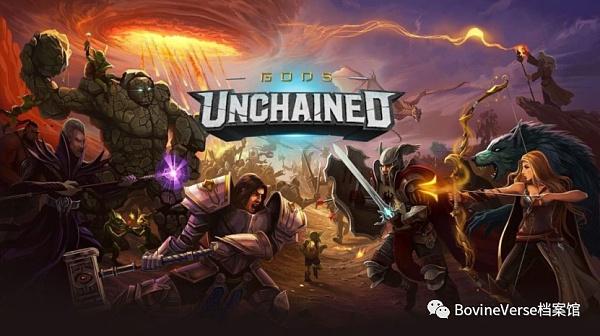
"Gods Unchained" is a free tactical card game released in 2019. Its gameplay is very similar to "Hearthstone." Led by the former game director of "Magic: The Gathering Arena," the game focuses on competitive play, meaning players must strategically outsmart their opponents by building decks capable of countering various tactics.
In "Gods Unchained," players fully own their digital items, primarily trading cards, which appear as NFTs, allowing them to freely trade, sell, and use their cards in any way they like—just like owning real, tangible cards.
There are several game modes to choose from. The single-player mode pits you against computer opponents, designed for players to train and test new decks. The constructed mode allows you to face off against opponents online, enabling players to earn experience points, upgrade, and unlock new cards.
If you are a serious player looking to climb the ranks, you will need to enter ranked constructed play. In addition to earning experience points, you can unlock rewards and gain Flux (the local token), which provides crafting capabilities in the Gauntlet of Gods.
New players will receive 2 classes of 70 different cards, totaling 140 cards, as part of a welcome set. These pre-constructed decks are designed to help new players enter the game by showcasing different features and strategies provided by the six gods (types). Additionally, basic cards (called core cards) are also provided.
While most cards are minted as NFTs, some cards, particularly the free core cards, are not minted on the blockchain. Core cards obtained in the game are not blockchain-native but can be fused together to improve their quality. Through fusion, these cards become actual NFTs on the blockchain. You can exchange them for cryptocurrencies to obtain the cards you want to complete your collection.
Play-to-earn (P2E)
Play-to-earn (P2E) refers to players earning income by playing games. Different games have their own economies, strategies, and methods for establishing a reliable income stream.
A typical example is selling resources in the game that require a significant time investment to obtain. Other players seeking convenience and a faster gaming experience but unwilling to invest time are often very willing to pay for this.
P2E is not a new phenomenon. Before the emergence of blockchain-based NFT games, entrepreneurial players already existed. The massively multiplayer online role-playing game (MMORPG) released by Jagex in 2001 has been a primary source of income for many Venezuelans over the past few years. Selling gold in World of Warcraft or accounts in RuneScape is still very popular today.
However, P2E players rely on third-party platforms to trade and sell their in-game currencies. These platforms are often illegal, as they are not authorized by the game developers and violate the game's terms and conditions.
In 2021, we began to see massive growth in game NFTs. This can largely be attributed to the parabolic rise of Axie Infinity, both in the price of its native token AXS and the daily active users it gained (1.8 million as of August 2021). Such impressive growth metrics also placed "Axie Infinity" at the top of crypto protocol revenues.
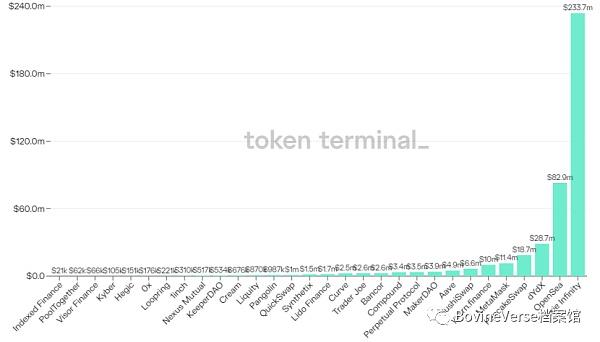
Source: Token Terminal - 30-day protocol revenue as of 28 September 2021
Case Study: Axie Infinity
The success of "Axie Infinity" can largely be attributed to its strong P2E elements. There are currently four main ways for players to earn money by playing.
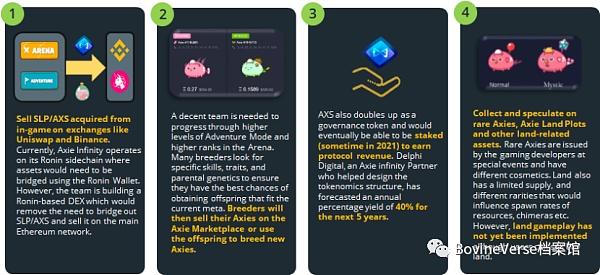
Source: CoinGecko Q2 2021 Report
To truly understand how profitable playing "Axie Infinity" can be, here is a typical daily routine using the most popular method to earn SLP. We tested the game ourselves and proposed a basic case approximation.
Game Notes:
Players earn SLP from matches, with each entry requiring 1 energy. A team of 3 Axies (the minimum requirement for a match) provides 20 energy daily.
Energy is not required to earn SLP in adventure mode. However, Axies need energy to gain experience points, which improve their stats. We assume an average of 10 energy is spent daily on leveling up.
This leaves 10 energy to spend in the arena. Depending on your matchmaking rating (MMR), you will earn different amounts of SLP. Additionally, you can only earn SLP if you win the match. We will assume an average of 15 SLP per match (the average SLP earned from MMR levels 1550-1650), winning 5 matches daily.
Winning 10 matches in adventure mode and 5 matches in arena mode will grant 25 SLP as part of the daily quest rewards.
Estimated Daily SLP Rewards
Adventure Mode = 50 SLP
Arena Mode = 75 SLP
Daily Quest = 25 SLP
Total SLP Earned = 150 SLP
Estimated Time Investment
Based on our own experience, a match with a small Axie lasts about 5 minutes. This means 100 minutes of pure gameplay time. More conservatively, if we include break times, loading times, and playing in adventure mode (before reaching the 75 SLP cap), we can approximate a total daily time investment of about 4 hours.
Wage Comparison
Based on these assumptions, if the SLP price is $0.1, the income calculation for an Axie player compared to minimum wage jobs in selected countries (pre-tax) is as follows:

Daily wage rates based on each country's respective minimum wage, sourced from the UK government, US Department of Labor, and ASEAN Briefing
Monthly earnings are based on an 8-hour shift, with Axie Infinity capped at 20 energy per day.
Please note that this is just a basic case earnings rate. Players with 20 or more Axies can use 60 energy daily. While the cap in adventure mode is 75 SLP, players will be able to take advantage of more opportunities to earn SLP. Not to mention that AXS and SLP rewards are also allocated to top players in tournaments and seasons.
In any case, earning $450 per month by Southeast Asian standards is already quite substantial, as it only requires about 4 hours of work daily. Remember, Axie Infinity is not a job; it is a game. People are simply rewarded for playing a game primarily designed for entertainment!
However, not everyone can afford a team of Axies. As of November 2021, the average floor price for one Axie was $115. A person would need to invest approximately $345 upfront to meet the minimum requirement of playing with 3 Axies. This is a significant amount, especially for participants from developing countries lacking basic income.
To address this issue, Axie Infinity allows Axies to be lent through their system. Sponsors can rent out Axies by sharing their MavisHub password with scholars. Scholars do not have control over these assets, as they are linked to the owner's Ronin wallet, but they can still play the game.
In return, scholars sign a profit-sharing agreement, where the SLP earned in the game is shared between both parties. This has given rise to a new category of "employment" known as Axie scholarships. Some scholars even have resumes!
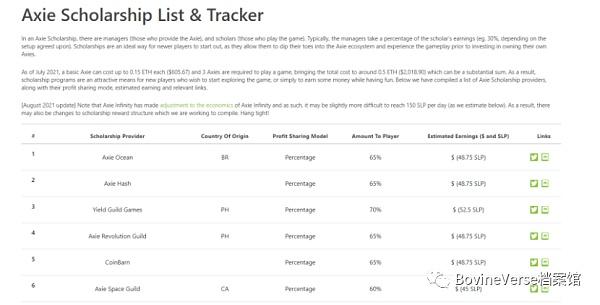
Source: CoinGecko
To provide some context, here is an example of the expected returns for Axie sponsors and scholars. Our assumptions are as follows:
- The SLP price remains at $0.1 over the course of a year.
- The upfront cost for each team is $345.
- The asset price (Axies) remains unchanged over the course of a year.

Axie scholarships are very popular because they lower the barrier to entry for playing the game. At the same time, investors have begun to take notice of the Axie economy; dedicated hedge funds (like Blackpool) and decentralized gaming guilds (like Yield Guild Games) are actively investing in the game through the scholarship system. More institutional and private investors are starting to realize the potential of P2E, and it is only a matter of time.
"Axie Infinity" may currently be the king of P2E, but other games are also beginning to capitalize on the P2E trend. Technically, any cryptocurrency game with tradable assets can be considered a P2E game. Moreover, more developers are starting to actively market their products in P2E form, especially due to their low barriers to entry aimed at attracting free-to-play (F2P) players.
As more players enter the system, each game transforms into its own virtual economy, driven by the current state of the game and market demand; developers derive their true influence by controlling the rules of the game. This is very similar to government actions and reactions, but patch updates are not policies and regulations; they serve as a means to protect the economy.
Many of the games we discussed in this chapter are very new, and others have not even been released yet (to be discussed below). Even "Axie Infinity," one of the oldest blockchain games released in 2018, is still in its Alpha phase.
The P2E phenomenon has undoubtedly redefined gaming and proven itself to be an inevitable way to attract new players, but whether the in-game economy is sustainable is an entirely different matter. Developers are still trying to come up with the right formula. Each game must be judged based on its own characteristics.
However, once a solid business model and token economic model are developed, it will be inevitable to disrupt the entire gaming industry.
Project Examples

Star Atlas
"Star Atlas" is an upcoming space-themed grand strategy game set in the metaverse of 2620. Like "EVE Online," players must manage politics, trade routes, and economic production sectors. Every asset in the game is represented as an NFT, which players can find or create.

Illuvium
Illuvium is an upcoming open-world RPG adventure game. Like "Pokémon," players can explore the world and capture god-like creatures called Illuvials, which are also NFTs. A key differentiating factor is the combat system. Similar to auto chess, battles can also occur automatically on the board. Players can earn Illuvium (ILV) by climbing the leaderboard through gameplay.

Plants vs Undead
"Plants vs Undead" (PVU) is a P2E tower defense game based on Binance Smart Chain (BSC). Similar to the popular "Plants vs Zombies" series, players will need to use their plant NFTs to fend off hordes of the undead.

R-Planet
R-Planet is about creating and collecting NFTs. Players are incentivized to mine and synthesize new elements, expanding their collections through a story rooted in space exploration. Native NFTs can also be used to earn in-game currency, Aether.

Alien Worlds
"Alien Worlds" is a resource-based game focused on governance and mining. Six different factions govern six planets. Each faction operates as a DAO and competes with each other using the in-game currency, Trilium, to develop their planetary economies.

MyNeighbourAlice
"MyNeighbourAlice" is a narrative-driven RPG story inspired by Animal Crossing. Players build on land and engage in social interactions with friends and other players. Almost all items in the game are NFTs.
Conclusion
The gaming industry has thrived in the internet age. However, fundamental limitations such as developer overreach and intellectual property restrict the growth of a true gaming economy. Integrating NFTs may not be a new concept, but it could become the medium that supports the next generation of games.
Games like "Fortnite," "Dota 2," and "Counter-Strike" are examples of free-to-play (F2P) games that generate revenue through "skins" (virtual fashion items) and other cosmetic-related effects. However, the key difference is that players do not technically own these skins. NFTs can enable players to freely manage their assets.
Furthermore, developers can build on existing games, integrating them with other dApps on decentralized networks to provide various exciting gaming opportunities. For example, two games could collaborate within the game or even integrate with existing financial dApps to offer financial services to players.
With this newfound freedom, more games are beginning to introduce P2E mechanisms. Game developers can leverage enticing economic incentives to attract players. However, creating a powerful P2E economic game that is inherently entertaining is not easy.
While games provide players with entertainment and economic freedom, establishing a balanced flywheel effect is challenging. The industry is still in its infancy; however, the potential benefits and opportunities are endless.
As more games begin to refine successful formulas, we look forward to seeing more traditional gaming giants enter the cryptocurrency space. We have already begun to see signs of this trend. Companies like Electronic Arts (EA) are currently seeking new partners with NFT and blockchain experience, and EA's CEO has publicly stated, "NFTs are an important step for the future of the industry. It is only a matter of time before blockchain becomes the main network infrastructure for the gaming industry."



